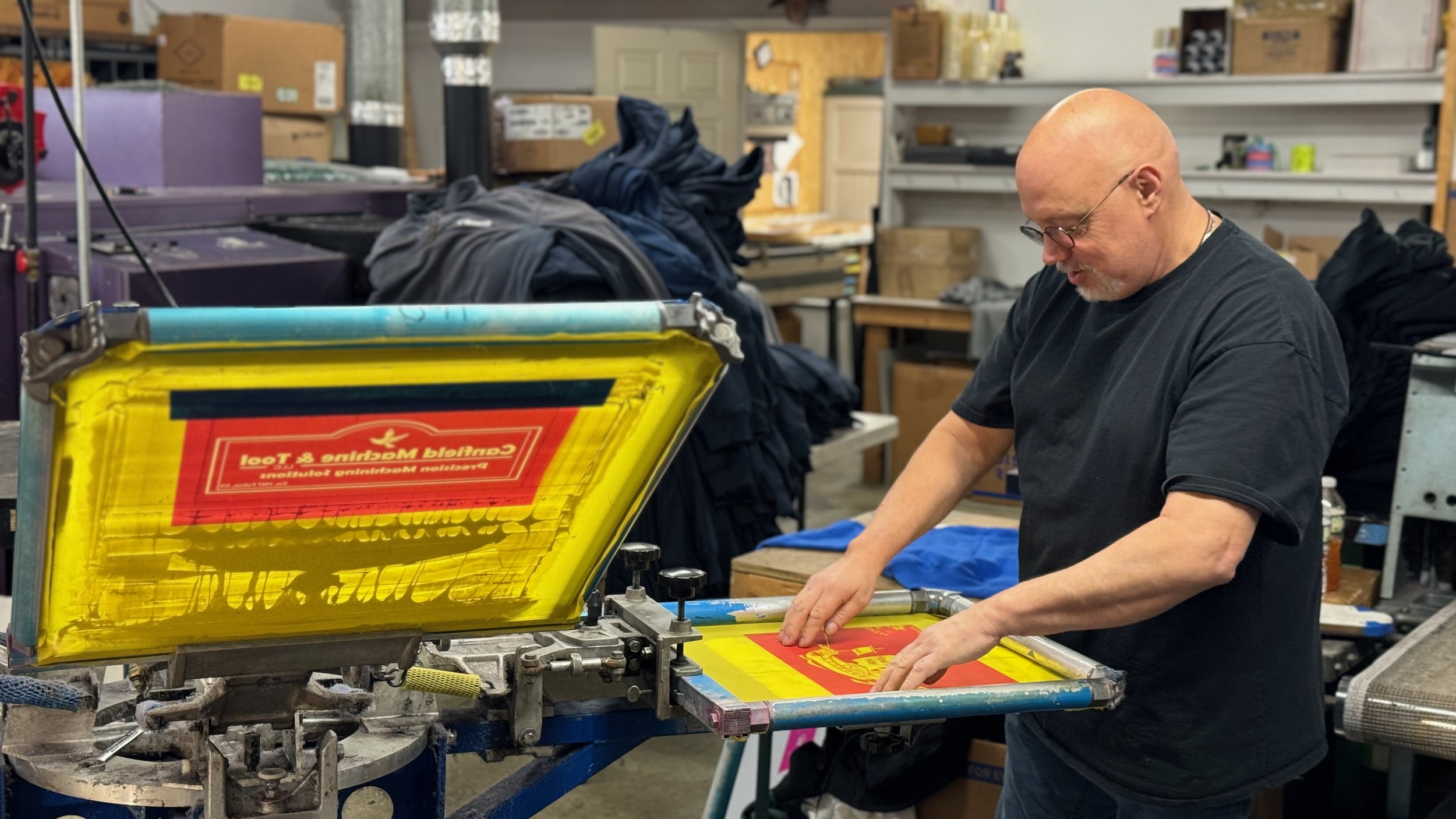Creative T-Shirt Printing Ideas for Small Brands
Creative T-Shirt Printing Ideas for Small Brands
Blog Article
Display Printing Uncovered: Everything You Required to Understand About T-Shirt and Garment Printing Techniques
If you've ever questioned just how those lively layouts wind up on your preferred tees, you're in the appropriate place. Screen printing is a remarkable technique that incorporates art with technique, offering endless possibilities for imagination. Comprehending the principles, from equipment to ink choices, can greatly influence your outcomes. Prepared to explore the essential elements that make display printing an art type? Let's uncover the details that can raise your jobs.
The Essentials of Display Printing: Exactly How It Works
When you dive right into display printing, you'll find it's both a science and an art. At its core, display printing entails creating a pattern, or display, that enables ink to pass with only in particular areas.
Placement the screen over the fabric, then use a squeegee to press ink with the display onto the garment. Each step is essential, and grasping them will elevate your screen printing abilities, transforming simple garments into distinct, expressive pieces.
Kinds of Screen Printing Strategies
Once you comprehend the basics of display printing, it's time to explore the different techniques that can raise your styles. One prominent technique is traditional display printing, where ink is pushed through a stenciled display.
If you're intending for great information, consider discharge printing. This strategy gets rid of dye from the textile, leaving a soft, classic look. Another choice is plastisol printing, known for its durability and brilliant shades, making it a preferred for several brands. Experiment with halftone printing to produce slope effects and complex layouts. Each technique has its one-of-a-kind appeal, so do not wait to attempt them out to discover what fits your style best!
Crucial Tools for Screen Printing
To attain sensational results in display printing, having the ideal devices is essential. You'll require a strong display printing framework, which holds the mesh that transfers your design onto the garment. Next off, invest in top quality mops; these are crucial for using ink evenly throughout the display.
Selecting the Right Inks and Products
When choosing inks and materials for screen printing, you need to consider the kind of ink that works best for your task. Consider fabric compatibility to ensure your styles look wonderful and last lengthy. Additionally, discover green ink alternatives to make your printing process much more lasting.
Kinds of Screen Inks
Choosing the appropriate screen ink is crucial for accomplishing dynamic, durable prints that meet your job's requirements. There are a number of types of display inks to examine. Specialty inks, such as metallic or glow-in-the-dark, can add one-of-a-kind results to your designs.

Material Compatibility Considerations
Understanding textile compatibility is vital for accomplishing top notch screen prints, especially given that various materials respond uniquely to various inks. When picking inks, consider the fabric kind-- cotton, polyester, or blends. For cotton, water-based inks function well, supplying softness and breathability. Polyester, on the other hand, often needs plastisol inks for much better attachment and lively shades. You may require to utilize a combination of both types if you're publishing on blends. Always examine your inks on example material to guarantee they stick appropriately and maintain color stability. Additionally, keep in mind that fabric weight and appearance can affect the last outcome, so choosing the right ink and material combo is vital for your job's success.
Eco-Friendly Ink Options
Eco-friendly inks are becoming a popular selection for display printers who desire to decrease their ecological impact while preserving high quality. When selecting inks, consider water-based inks, which are less damaging and much easier to cleanse up contrasted to standard solvents.
In addition, seek inks made from sustainable sources, such as soy or vegetable-based alternatives. By picking the best inks and products, you'll not only develop magnificent designs however likewise add to a much more sustainable printing process. Make the switch, and your prints will show your dedication to the atmosphere!
Preparing Your Layout for Screen Printing

Submit Layout Requirements
To guarantee your design looks vivid and sharp on fabric, you'll require to pay attention to submit format demands for display printing. Beginning with vector documents like AI or EPS, as they can be scaled without shedding high quality. If you utilize raster pictures, go with high-resolution data, such as TIFF or PNG, ideally at 300 DPI. Avoid utilizing JPEGs, as they can shed clearness when resized. Make sure your design has a clear history to protect against unwanted white edges on your prints. Finally, maintain click shade modes in mind; CMYK is conventional for screen printing, so convert your RGB makes as necessary. By following these guidelines, you'll establish your art work up for an effective print.
Shade Separation Methods
Shade separation is an essential action in preparing your layout for display printing, and understanding it can significantly improve your print top quality. You'll need to break your design right into individual shades, as each shade requires a different display during printing. This accuracy not only ensures accurate shade representation however also streamlines the printing procedure.
Resolution and Dimension
Accomplishing the very best results in display printing begins with assuring your design has the best resolution and size. Ideally, your art work needs to go to the very least 300 DPI (dots per inch) for sharp, clear prints. If you utilize lower resolution, your last product may look less than professional and pixelated.
When it comes to dimension, take into consideration the dimensions of your print area. Layout your art work to match the final print size, preferably producing it in the real dimensions you'll like it be publishing. In this manner, you'll prevent any kind of unexpected scaling problems.
Always check your design in both vector and raster styles. Vector graphics can be scaled without losing quality, making them suitable for display printing. Preparing appropriately will assure your design looks remarkable on every garment!
Step-by-Step Display Printing Process
Display printing is a vibrant process that enables you to create vivid designs on various surface areas. To get started, you'll need a display, solution, and your picked ink.
After rinsing the unexposed solution, your display is all set. Set it up on your printing surface area and align your garment beneath it. Put ink onto the display and utilize a squeegee to push the ink through the pattern onto the textile. Raise the display very carefully and let the print completely dry. Finally, cure the ink making use of warm to ensure longevity. That's it! You've successfully screen printed your style.
Tips for Successful Screen Printing Projects
While you're diving right into your screen printing tasks, bear in mind that prep work is essential to success. Begin by gathering all your products-- inks, mops, garments, and displays. A tidy workspace assists avoid unwanted mistakes, so clean before you start.
Following, confirm your art work is high-resolution and effectively sized for your garment. Examine your screen for correct exposure and tidy it extensively to stay clear of spots. you could check here When mixing your inks, follow the producer's guidelines to accomplish the appropriate consistency.
Throughout printing, use even pressure with your squeegee for constant results. Do not rush; take your time to confirm each print meets your requirements. After printing, let your garments completely dry totally prior to managing or packaging them.
Finally, always maintain an example of your benefit future referral. By doing this, you can analyze your development and enhance your strategies gradually. Pleased printing!

Often Asked Inquiries
How much time Does It Take to Establish a Display Printing Task?
Establishing a screen printing job commonly takes around 30 mins to an hour. You'll prepare the screens, mix inks, and adjust journalism. The time differs based on complexity and experience, so stay organized!
Can I Print on Various Textile Keys In Utilizing the Exact Same Method?
Yes, you can publish on different textile types utilizing the exact same method, but you'll require to change your setups and inks. Some materials take in ink in a different way, so exploring assurances the very best results for each material.
What Are Common Blunders to Avoid in Screen Printing?
When screen printing, avoid typical mistakes like making use of the incorrect ink, overlooking appropriate direct exposure times, or missing pre-press checks. Always test your setup and preserve clean displays to guarantee quality results each time.
Just How Can I Appropriately Tidy and Maintain My Display Printing Equipment?
To effectively tidy and maintain your screen printing equipment, you ought to regularly clean screens with proper solvents, inspect squeegees for wear, and guarantee all tools are saved dry and dust-free. Consistency boosts and stops costly repair services efficiency.
Is Display Printing Ecologically Pleasant Contrasted to Various Other Techniques?
Display printing can be a lot more eco-friendly than other approaches, specifically if you utilize water-based inks and eco-conscious products. By selecting sustainable supplies and practices, you minimize waste and lessen your influence on the earth.
Screen Printing Uncovered: Whatever You Need to Know Regarding T-Shirt and Garment Printing Methods
At its core, display printing entails producing a stencil, or display, that enables ink to pass through just in particular locations. Placement the screen over the textile, then utilize a squeegee to push ink with the display onto the garment. One preferred approach is conventional display printing, where ink is pushed via a stenciled screen.When selecting inks and products for screen printing, you need to take right into account the kind of ink that works best for your task.
Report this page